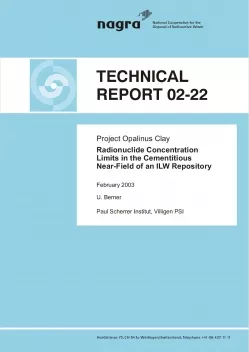
Technical Report NTB 02-22
Project Opalinus Clay: Radionuclide Concentration Limits in the Cementitious Near-Field of an ILW Repository
The disposal feasibility study currently performed by Nagra includes a succession of quantitative models, aiming at describing the fate of radionuclides potentially escaping from the repository system. In this chain of models the present report provides the so called "solubility limits" (maximum expected concentrations) for safety relevant radionuclides from ILW wastes, disposed of in a chemically reducing, cementitious environment.
From a chemical point of view, the pore waters of hydrated cement matrices provide an exceptional environment. Compared with usual ground waters exhibiting pH-values of around 8, cement pore waters are strongly alkaline with pH-values from 12.5 to 13.5 and contain nearly no carbonate and only little sulfate. Oxides and hydroxides mainly determine solubility and speciation of the elements.
Solubility and speciation calculations in cementitious pore waters were performed using the very recently updated Nagra/PSI Chemical Thermodynamic Data Base (TDB) for the majority of the 36 elements addressed as potentially relevant. Wherever possible, maximum concentrations compiled in this report were based on geochemical calculations. In order to ensure full traceability, all thermodynamic data not included in the TDB are explicitly specified in the document. For similar reasons the compilation of results (Table 1) clearly distinguishes between calculated and recommended items. The heading "CALCULATED" lists maximum concentrations based on data fully documented in the TDB; results under the heading "RECOMMENDED" include data from other sources.
The pH sensitivity of the results was examined by performing calculations at pH 13.4, in accordance with the pH of non-altered cement pore water. Solubility increases predominantly for elements that tend to form anionic hydroxide complexes (Sn, Pd, Zr, Ni, Eu, Cd, Mo, Co). Oxidizing conditions around +350 mV might be expected in the environment of nitrate-containing wastes. In this case, significant solubility increases were calculated for U, Np, Pu, Se and Ag.
Special attention is allocated to the uncertainties of the evaluated maximum concentrations, expressed as upper-and lower limits. The conceptual steps to determine these uncertainties are explained in the section 3. Due to lack of data, it was not always possible to assess uncertainties in a manner consistent with that used to assess the solubility limits. For some elements, uncertainties had to be derived from less sharply defined data or even with the help of estimates. Such less rigorous approaches are justified by the fact that in performance assessments particularly the upper limits are as important as are the maximum concentrations themselves. However, appropriate information was available to define an upper limit for nearly all of the relevant nuclides.
